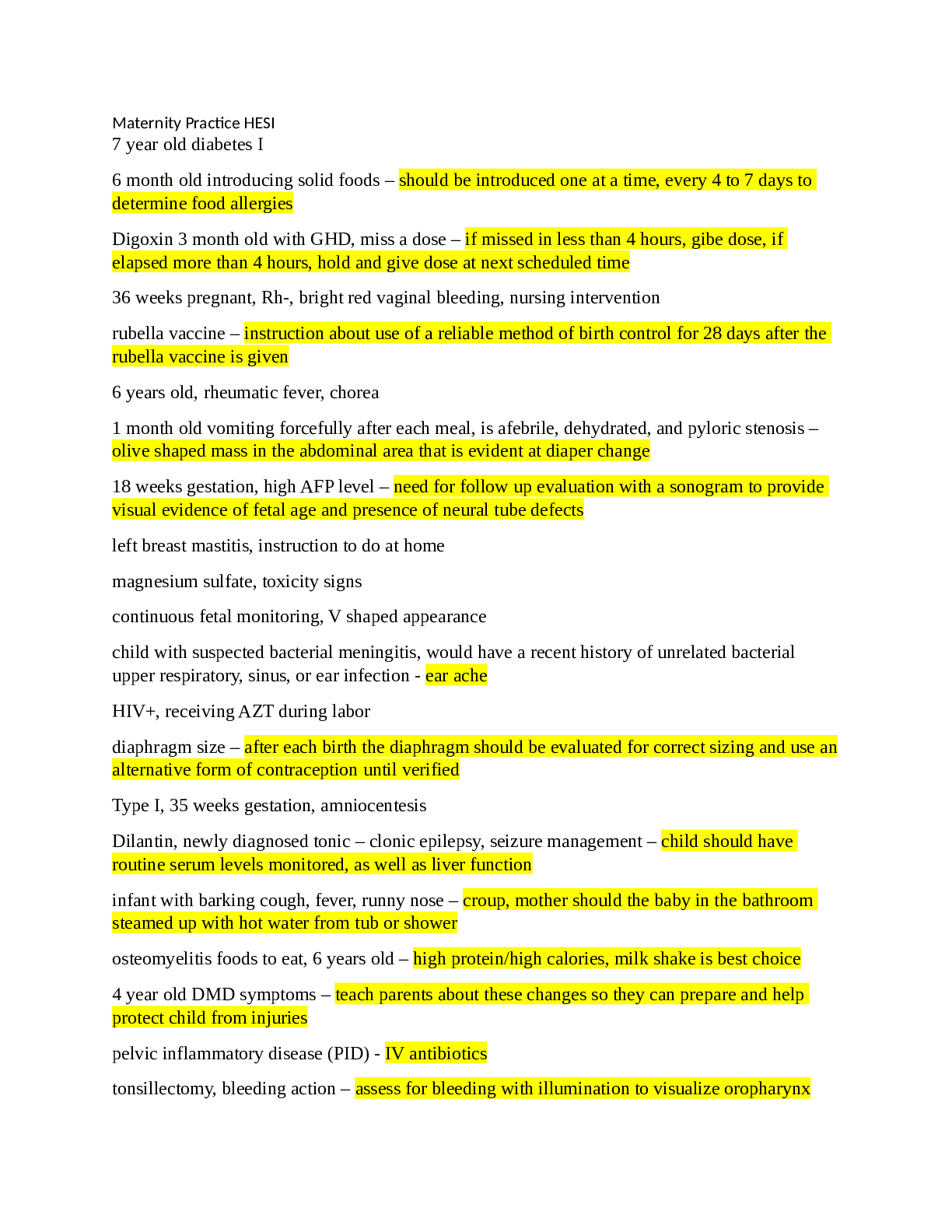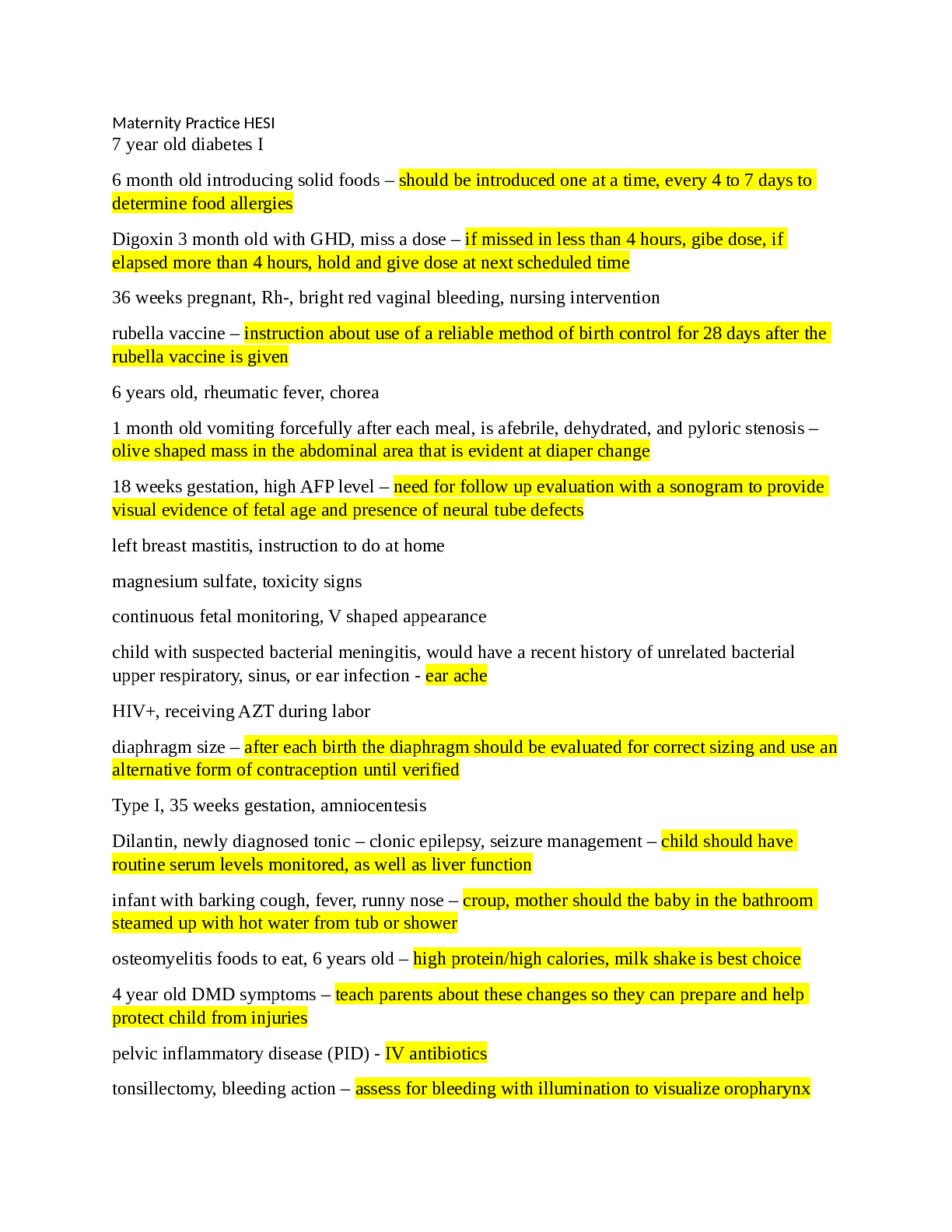Maternity Practice HESI
7 year old diabetes I
6 month old introducing solid foods – should be introduced one at a time, every 4 to 7 days to
determine food allergies
Digoxin 3 month old with GHD, miss a dose – if missed in less than 4 hours, gibe dose, if
elapsed more than 4 hours, hold and give dose at next scheduled time
36 weeks pregnant, Rh-, bright red vaginal bleeding, nursing intervention
rubella vaccine – instruction about use of a reliable method of birth control for 28 days after the
rubella vaccine is given
6 years old, rheumatic fever, chorea
1 month old vomiting forcefully after each meal, is afebrile, dehydrated, and pyloric stenosis –
olive shaped mass in the abdominal area that is evident at diaper change
18 weeks gestation, high AFP level – need for follow up evaluation with a sonogram to provide
visual evidence of fetal age and presence of neural tube defects
left breast mastitis, instruction to do at home
magnesium sulfate, toxicity signs
continuous fetal monitoring, V shaped appearance
child with suspected bacterial meningitis, would have a recent history of unrelated bacterial
upper respiratory, sinus, or ear infection - ear ache
HIV+, receiving AZT during labor
diaphragm size – after each birth the diaphragm should be evaluated for correct sizing and use an
alternative form of contraception until verified
Type I, 35 weeks gestation, amniocentesis
Dilantin, newly diagnosed tonic – clonic epilepsy, seizure management – child should have
routine serum levels monitored, as well as liver function
infant with barking cough, fever, runny nose – croup, mother should the baby in the bathroom
steamed up with hot water from tub or shower
osteomyelitis foods to eat, 6 years old – high protein/high calories, milk shake is best choice
4 year old DMD symptoms – teach parents about these changes so they can prepare and help
protect child from injuries
pelvic inflammatory disease (PID) - IV antibiotics
tonsillectomy, bleeding action – assess for bleeding with illumination to visualize oropharynxCeftriaxone, + gonorrhea
APGAR, 1/10, color is acrocyanotic
young girl, UTI
9 year old, celiac disease, appendectomy, food to not eat – crackers = have gluten
history of preeclampsia, high blood pressure
what to use when changing newborn’s diaper – plain water
18 year old daughter, serum test results
38cm fundal height, 30 weeks gestation – after 20 weeks, the fundal height in cm should
approximate # of weeks gestation
5 year old, bowel movement, yellow, sticky, smells like sour milk – typical for breastfed
newborns, continue to breastfeed
absence of testes on newborn admission assessment
3 month old does not sleep through the night
14 month old, hospitalized – febrile seizures
3 year old girl, blind since birth, hospitalized, compound fracture of the femur and is now in
traction, intervention
fundal massage technique – anchor the lower uterine segment with one hand, while massaging
the fundus with the other hand, to prevent uterine prolapse and uterine inversion
Maternity HESI
4. The nurse is teaching a client with gestational diabetes about nutrition and insulin need for
pregnancy. Which content should the nurse include in this client’s teaching plan?
A) Insulin production is decreased during pregnancy
B) increase daily caloric intake is needed ?
C) injection requirements remain the same
D) Blood sugars need less monitoring in the first trimester5. A 38-week primigravida client who is positive for Group A Beta Streptococcus receives a
prescription for cefazolin 2 grams IV to be infused over 30 minutes. The medications available in
2 grams/100 ml of normal saline. The nurse should program the infusion pump to deliver how
many ml/hour?
1.6ml/hr
7. When performing the daily head-to-toe assessment of a 1-day-old newborn, the nurse observes
yellow tint to the skin on the forehead, sternum, and abdomen. What action should the nurse
take?
A) Measure bilirubin levels using transcutaneous bilirubinometry
B) Review maternal medical records for blood type and Rh factor
C) Prepare the newborn for phototherapy ?
D) Evaluate cord blood Coomb’s test results
8. A new mother asks the nurse about an area of swelling on her baby’s head near the posterior
fontanel that lies across the suture line. How should the nurse respond?
A) “That is called caput succedaneum. It will absorb and cause no problems.”
B) “That is called a cephalhematoma. It will cause no problems.” ?
C) “That is called a cephalhematoma. It can cause jaundice as it is absorbed.”
D) “That is called caput succedaneum. It will have to be drained.”
9.A 39-week-gestational multigravida is admitted to labor and delivery with spontaneous rupture
of membranes (SROM) and contractions occurring every 2 to 3 minutes. A vaginal exam
indicates that the cervix is dilated 6 cm, 90% effaced, and the fetus is at a +2 station. During the
last 45 minutes the fetal heart rate (FHR) has ranged between 170 and 180 beats/minute. What
action should the nurse implement?
A) Obtain a blood specimen for hemoglobin
B) Take an oral maternal temperature ?
C) Straight catheterize the client
D) Send amniotic fluid for analysis
Read More


